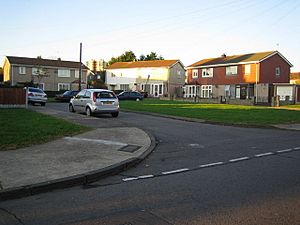Hainault, London facts for kids
Quick facts for kids Hainault |
|
|---|---|
 Housing in Hainault built by the LCC between 1947 and 1953 |
|
| Population | 12,953 (2011 Census. Ward) |
| OS grid reference | TQ445915 |
| • Charing Cross | 12.5 mi (20.1 km) SW |
| London borough | |
| Ceremonial county | Greater London |
| Region | |
| Country | England |
| Sovereign state | United Kingdom |
| Post town | ILFORD |
| Postcode district | IG6 |
| Post town | CHIGWELL |
| Postcode district | IG7 |
| Dialling code | 020 |
| Police | Metropolitan |
| Fire | London |
| Ambulance | London |
| EU Parliament | Greater London |
| UK Parliament |
|
| London Assembly |
|
Hainault is a large suburban area in East London, England. It is part of the London Borough of Redbridge. Hainault is about 12.5 miles (20.1 km) northeast of Charing Cross, a famous spot in central London. Most of the homes in Hainault were built by the London County Council between 1947 and 1953.
The area used to be spread across different parishes like Chigwell and Dagenham. But in 1965, it all became one area within Greater London. Hainault is right next to the Metropolitan Green Belt, which is a protected area of open land. To the east, you'll find Hainault Forest Country Park. To the north, there's open land and the border with Essex. The area is served by the London Underground's Central Line.
Contents
Hainault's Past: A Look Back
What's in a Name?
The name Hainault has a cool history! It was first written as 'Henehout' in 1221. Later, in 1239, it was called 'Hyneholt'. This name comes from Old English. It means 'wood belonging to a religious community'. This is because Hainault Forest was owned by Barking Abbey, a religious group.
From the 1600s, the spelling changed to its modern form. People thought it was linked to Philippa of Hainault. She was the wife of King Edward III. But this connection was actually a mistake!
How Hainault Grew
Long ago, Hainault was mostly covered by a big forest. Nuns from Barking Abbey owned this land. It was part of the large Forest of Essex. The trees from this forest were mainly used to build ships and houses.
Over time, people needed less timber. But they needed more food! So, in 1851, a special law was passed. It allowed much of Hainault Forest to be cut down. In just six weeks, about 3,000 acres of woodland were cleared. That's a huge amount of trees!
Building in the area started after August 1856. This was when the Great Eastern Railway built a train line. It ran between Stratford and Loughton. In 1903, a new loop line opened from Woodford to Ilford. Hainault was one of the stations on this new line.
People hoped that homes would be built quickly after the railway arrived. But it took many years! Hainault station even closed in 1908, just five years after it opened. Building finally began in the late 1920s. The station then reopened in 1930.
Later, the train line was taken over by London Underground. This happened as part of a big project that finished in 1948.
After the Second World War, there wasn't much land left in London for new homes. So, the London County Council (LCC) bought land in nearby areas. They bought land in Chigwell, Dagenham, and Ilford in 1943. Building the Hainault Estate started in 1947 and finished in 1953. They built 2,779 houses. This style of building was called a 'cottage estate'. The names of the roads in Hainault often relate to the history of Hainault Forest.
Where is Hainault?
For mailing addresses, Hainault is split between the Chigwell and Ilford post towns. These are in the IG postcode area. The local telephone code is 020. The Hainault telephone exchange is just outside the Greater London border in Grange Hill.
Some of the places closest to Hainault are Goodmayes, Chigwell, Collier Row, Barkingside and Chadwell Heath.
Who Lives in Hainault?
The 2011 census looked at the people living in the Hainault ward of Redbridge. The largest group was White British, making up 60.7% of the population. The next largest groups were Other White (8.4%) and Black African (5.7%).
When it came to religion, 55.9% of people said they were Christians. About 8.6% identified as Muslim, and 7% did not state a religion.
Getting Around Hainault
The closest London Underground stations are Hainault and Grange Hill. Both of these stations are on the Central line.
You can also get around Hainault by bus. The area is served by London bus routes 150, 247, 362, 462, and the N8 night bus.
Sports and Fun
Hainault has local sports teams! Hainault Athletic Football Club plays in the Essex Sunday Combination League. They have two teams of players.
Manford Way FC was started in 1946. They used to play on a field near Grange Hill Station. Now, that area has houses. The club currently plays in the Essex Olympian League. Manford Way is the main road that goes through the Hainault Estate.


